Admiral, thank you very much for that introduction. Thank you for your leadership, sir. Tim Oliver, I know you’re out there as well. Thank you for all your hard work and for all
the folks from the Navy Submarine League who give us this great opportunity. Thank you for that.
My task here is to be right on target with the theme of the symposium, and that is the Navy’s maintaining the design for maritime superiority.
In keeping with the theme of the symposium, what better way to build upon how the Submarine Force is executing the design for maintaining maritime superiority than to hear from the CNO himself? Please roll the video of the CNO. (https://www.youtube.com/watch?v=mmTX0jlIUT4).
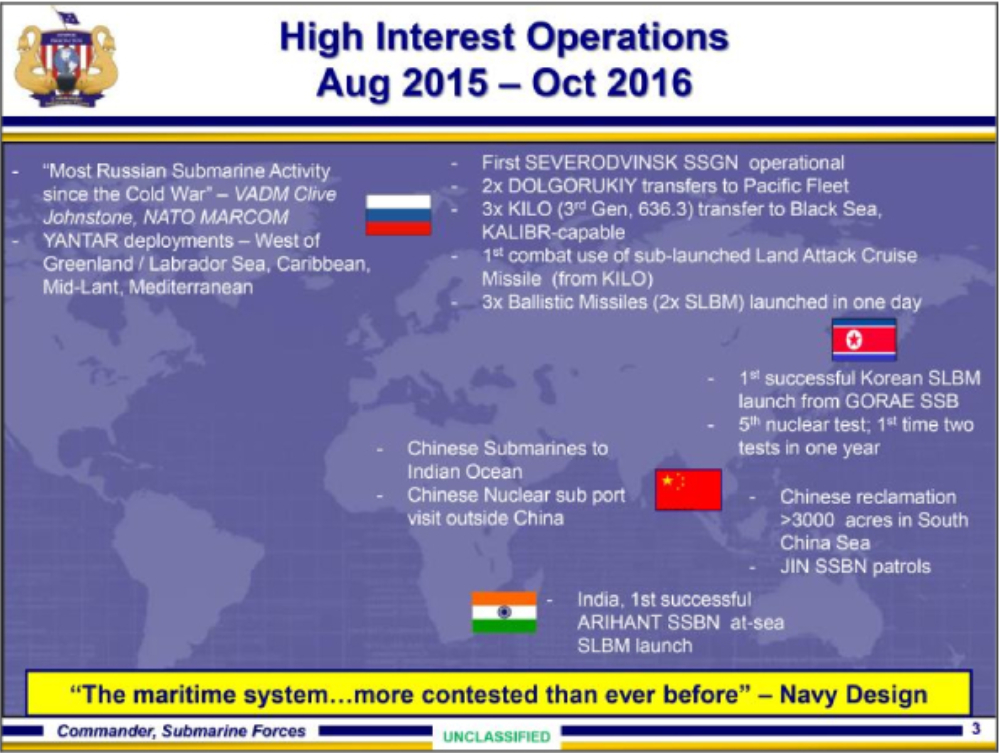
I think it’s important to start with, what’s been going on in the world since the last time we met. It’s pretty sobering, if you look at this chart with respect to Russian Submarine activity, very, very sobering. Talk to Vice Admiral Clive Johnstone, who is the NATO MARCOM commander. Here’s a quote from him: “The most Russian Submarine Activity since the Cold War.”
Since we last met, the SEVERODVINSK is operational. There are two DOLGORUKIY now in the Pacific fleet.
We’ve got Kalibr capable KILOs in the Black Sea. Clearly no reticence in actually using kinetic power from Russia, and the first combat use of submarine launched land attack cruise missiles from one of those KILOs. They just recently conducted a pretty significant show of force with three ballistic missiles launched two from submarines all in one day.
Meanwhile, over in Korea, I know some of the developments there are very, very concerning. The first successful Korean SLBM launch from a GOREA; the fifth nuclear test conducted by Korea actually the first time ever we’ve had two in one year. This is from a country that’s the only country to withdraw from the Nuclear Nonproliferation Treaty and the only country to test a nuclear weapon since the turn of the century.
China is obviously doing some things that stress the neighborhood there with the reclamation of land in the South China Sea. The JIN ballistic missile submarine is making patrols. There’s a recent report to Congress that talks about how sometime this year the Chinese, using the JIN, will conduct the first operational deployment of a SSBN. This would be the first time in your lifetime that someone other than Russia has held your family at risk from a submarine launched ballistic missile, from a country with which there is no START Treaty arrangement.
You get the picture. There’s been a lot going on in the world. It certainly underpins what the CNO was just talking about in his call to action.
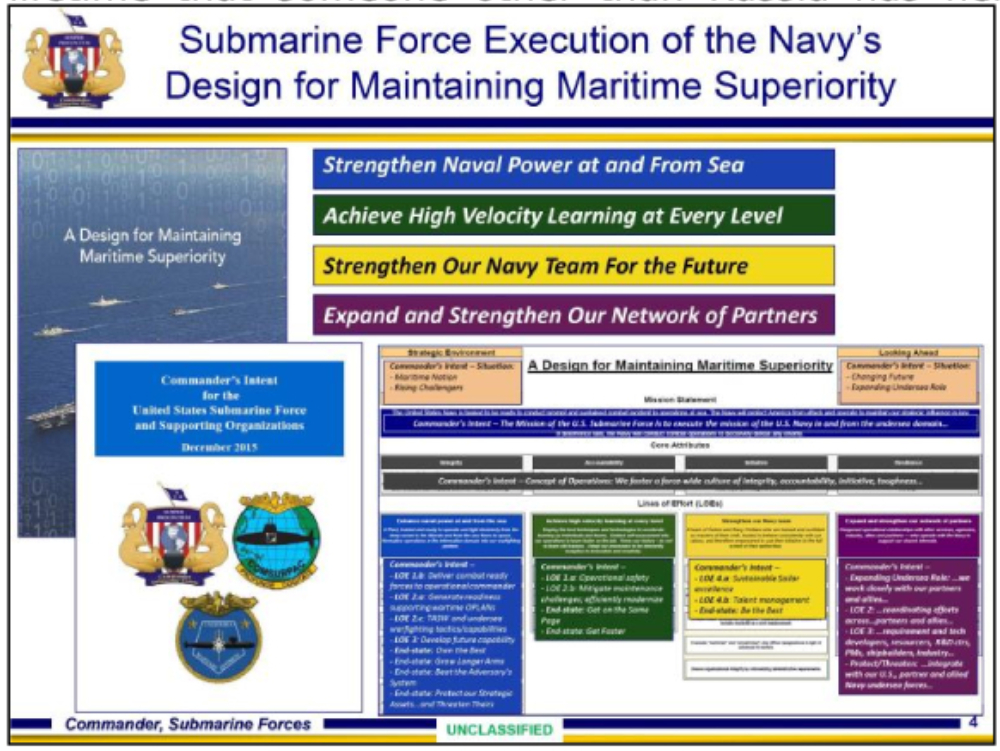
As was alluded to, here are the four lines of effort from the Design for Maintaining Maritime Superiority; you see here a place mat. Frankly, it’s impossible to take this entire document/booklet and put it in a place mat, but if you could this is what it would look like. Also here I show the Commander’s Intent document that Admiral Padgett was referring to, that Fritz Roegge, Chas Richard and I signed out.
I’ve overlaid that Commander’s Intent document onto that Design’s place mat, making the visual point that the Submarine Force is totally aligned with the CNO. So, just as Admiral Padgett referred to, we are very, very synchronized. You can hold these two documents up to the light and they are 100 percent aligned in where the Submarine Force is going and how that is 100 percent in support of where the CNO wants to take the Navy with Design for Maintaining Maritime Superiority.
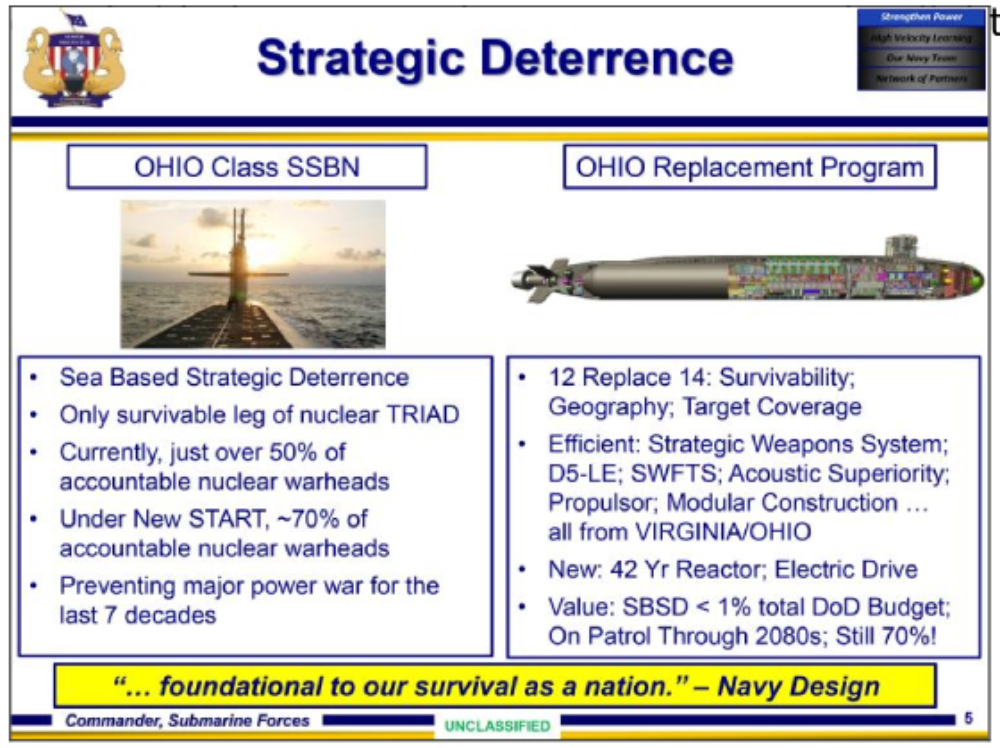
So now we’ll talk about some of the key elements from the Design that are manifest with the statement that I just made. First and foremost, Admiral Caldwell talked about it, Admiral Padgett talked about it in his opening remarks, is strategic deterrence. It should not be lost on anybody in this room that this quote from the Navy Design is as stated, Strategic Deterrence is “foundational to our survival as a nation,” period. It has prevented major power war for the past 70 years.
As you’ve heard, the sea based leg of that triad is going to be on patrol through the 2080s. We have to get this right and there is no time to waste. All margin is gone. We can do it, but we have to continue to move out on all the things that we are moving out on.
Just to put a finer point on what Admiral Caldwell said, we’ve actually started to build OHIO Replacement already, in the form of the Common Missile Compartment. I’m always quick to tell people that it doesn’t go on patrol in Fiscal Year 2031; it’s actually October of Calendar Year 2030. So there is no time to waste.
The OHIO-class, as we stand here right now, represents a little over 50 percent of the nation’s accountable nuclear warheads being carried on the sea-based leg of the triad. The other two legs of the triad combined are less than the Submarine Force alone, just as we stand here today at just a little bit above 50 percent. Under the New START Treaty, as Admiral Caldwell mentioned already, approximately 70 percent, seven-zero percent of the nation’s accountable nuclear warheads will be carried on the sea-based leg of the triad. That is a big number. Again, we have to get this right. This is something that has prevented major power war for the last 70 years.
So OHIO Replacement, we’re going to have 12 to replace 14. We went from 41 SSBNs to 18 to 14, and now it’s going to be 12. Those 12 are carrying 16 missile tubes, not the 24 missile tubes that were on OHIO.
We can do this. We have done the hard work. We have done the math. We have done that rigorous analysis. But 12 is the number, nothing less.
The force structure of the SSBN force is not a function of the number of warheads. It is a function of the three things that are listed here: survivability, geography and target coverage. That’s a much more sophisticated conversation than just the number of warheads. This ensures a credible two-ocean force, so that the other guy, when he wakes up in the morning, doesn’t even want to bother to come find us because it’s too hard. It’s in that way that we’re able to deter for the defense of our own country, and assure our allies at the same time.
Efficiency for this program extremely efficient. The American taxpayer is going to get a very high return on the investment here when you consider the things that we are pulling through from OHIO and VIRGINIA classes. Of course this also goes to that efficiency question because all of these things are now baked in across the Force. Take SWFTS, for example, the Submarine Warfare Federated Tactical Systems.
It’s the sonar system, the fire control system, the imaging system, the ESM system. All that being all together now and the SSBN being part of that family, all the money that is spent on working on the TI, tech insertions, and the APB program builds, the software part of it, all of that is leveraged automatically now into OHIO Replacement. That’s a big part of that efficiency question.
All of this is being pulled through to OHIO Replacement, the Strategic Weapons System, the fantastic work that Admiral Benedict and his team are doing, and a lot of that being proved out over here in OHIO. The D5-life extended missile, SWFTS, acoustic superiority, propulsor, modular construction, all of that from VIRGINIA and OHIO, tremendous lessons learned, tremendous efficiency there.
But there are some new things, new technologies, significant ones that are needed for acoustic superiority. Probably the two most notable: electric drive from an acoustic superiority standpoint; and the 42-year reactor which is absolutely a major, major part of why we’re able to do this: 12 to replace 14.
Value, I’ve already foot stomped this. About one percent of our DOD budget goes towards the procurement of the sea based strategic deterrent. So when you consider that this platform; which has prevented major power war for the last 70 years, is going to be on patrol through the 2080s, and is still going to be carrying roughly 70 percent of the nation’s accountable nuclear weapons; this is a tremendous return on investment. This is tremendous value, and the American taxpayer should be very, very proud of that.
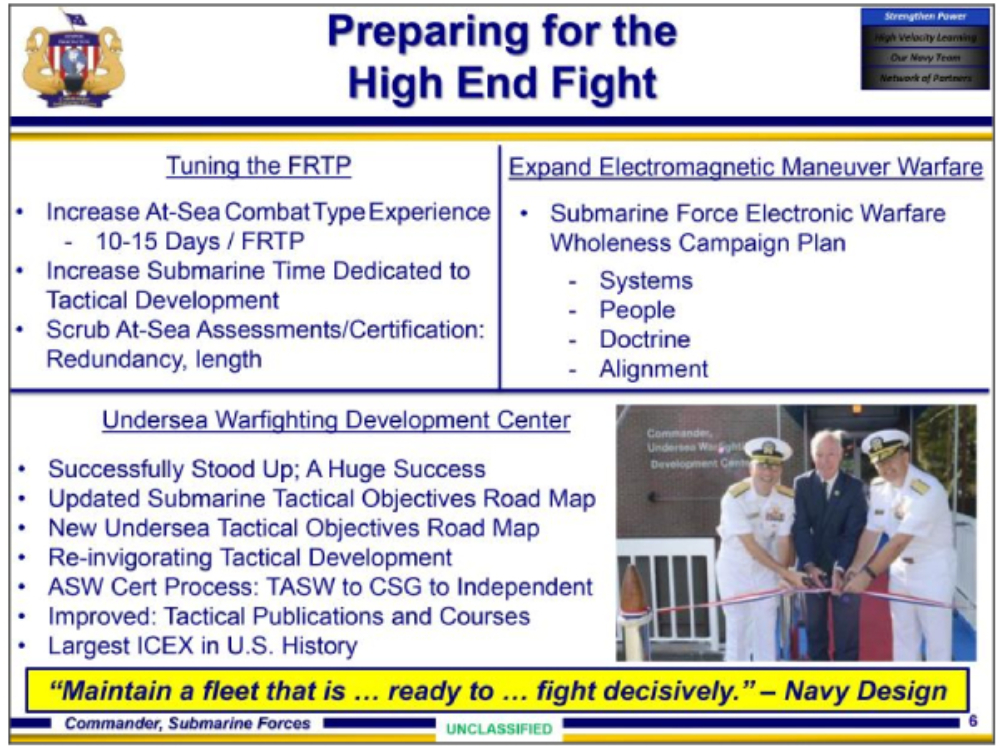
Another thing that we’re doing in the Submarine Force to help advance the design: preparing for the high end fight. Admiral Richardson talked about that in the opening video. The world’s oceans are more contested than ever. So some of the things that we’re doing, Admiral Roegge and I, we call “Tuning the FRTP.” The FRTP is the way we prepare submarines for their deployment, the Fleet Response Training Plan.
The bottom line is we’re trying to increase the amount of at sea combat type experience, sub-on-sub interactions, more tactical development. We’re really working hard by really scrubbing taking a hard scrub on our assessment and certification process to eliminate any redundancies, any overlaps, anything that we can take credit for in another way. Why test it again or test it twice or in a different way or at a different level? If we can wring out something north of 10 days of additional time, that would be a huge, huge victory.
So we are really working hard on that, sharpening our pencils, and trying to get after that.
The Submarine Force also has an Electronic Warfare Whole- ness Campaign Plan that’s taking a hard look at the systems, the people, the doctrine and the overall alignment. I would also put in the category of preparing for the high end fight; the Undersea Warfighting Development Center and the absolute success that this has been. It really has been a great success. This is not just for the Submarine Force, because it is not the Submarine Warfighting Development Center, it is the Undersea Warfighting Development Center.
Admiral Trussler, and now Admiral Pitts, bottom lines the ASW certification of carrier strike groups. He’s the guy that gives them their Tactical Readiness Examiniation, TRE, to put it in submarine parlance, from an ASW standpoint, that is. That’s huge. Admiral Merz has also had the same job in kind in a former life, and a former instantiation of that command (NMAWC).
But all of the warfare communities now have these warfighting development centers that fall in under the lead TYCOM, and again, the standup has been great. We have updated our own STORM, for those of you who remember what the STORM was, the Submarine Tactical Objective Road Map. We have adapted that model to the entire undersea and created an Undersea Tactical Objective Road Map.
We’re also reinvigorating tactical development, which was something that was needed, the entire certification process from Theater ASW to carrier strike groups to independent deployers. We just completed the largest ICEX in U.S. history, four different nations, four different services, four different branches of government, 35 different organizations, two submarines, and 150 people on a moving ice floe over the course of that time. It’s absolutely eye watering. Nobody else has done anything like that—really huge.
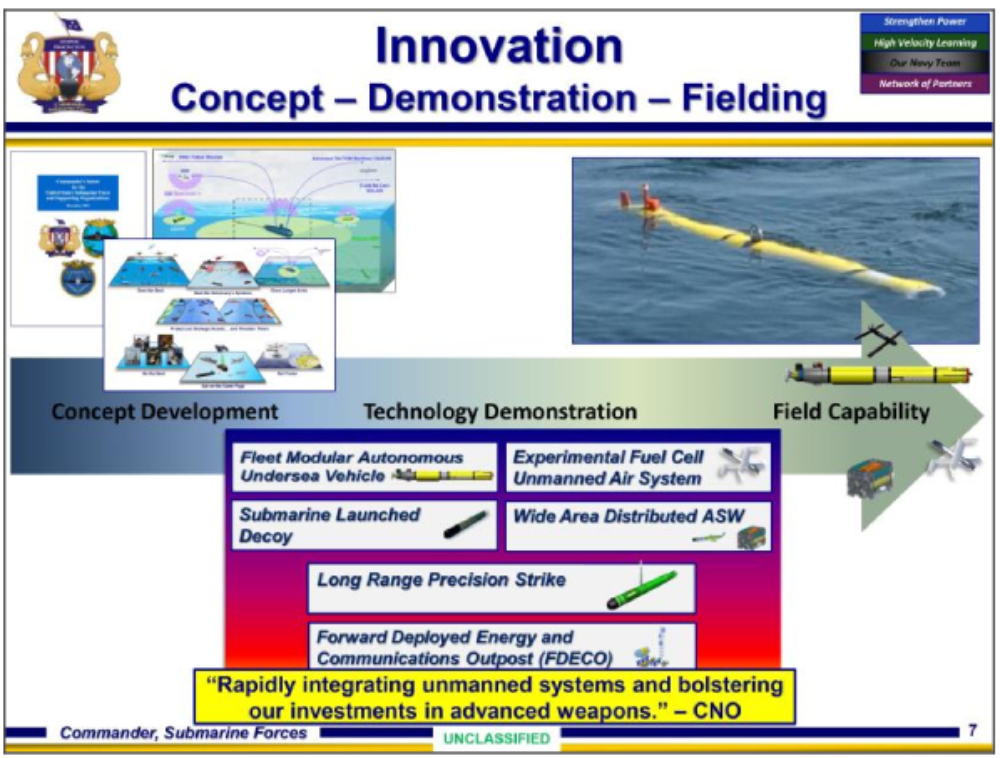
Innovation a big part of what we’re doing and right on target with what Admiral Caldwell is challenging us with. It’s in the Commander’s Intent and a big part of what we call Vision 2025. One of those little icons in the upper left corner is Get Faster, which is certainly right in line with what you heard the CNO say about High Velocity Learning.
So we’re really working hard to drag things across that Science and Technology, S&T, gap and go from concept; as laid out in things like Vision 2025, and the Commander’s Intent; to field a capability with the goal of trying to do it in two years, where possible, and we’re having success.
At the same time, there are going to be speed bumps. You can’t be afraid to fail in this kind of business. You’ve got to learn from it. You’ve got to absolutely learn from every single lesson.
There have been some great successes. Some of them are shown on the slide here. I’m not going to go into each one of these; including the Wide Area Distributed ASW, the Fleet Modular AUV, Project 1319, some UAVs: Blackwing, a small UAV launched from the signal ejector with about an hour endurance; and XFC, Experimental Fuel Cell UAV, which is launched from a torpedo tube with about a nine to 10-hour endurance.
FDECO is another technology demonstration, Forward Deployed Energy and Communication Outpost. I mention that only because this is an example of what Admiral Caldwell was referring to with thinking out of the box when it comes to UUVs. The FDECO station allows the UUV to plug in and get its power from a station, not from the submarine; to get to another way to look at Sydney Freedberg’s question.
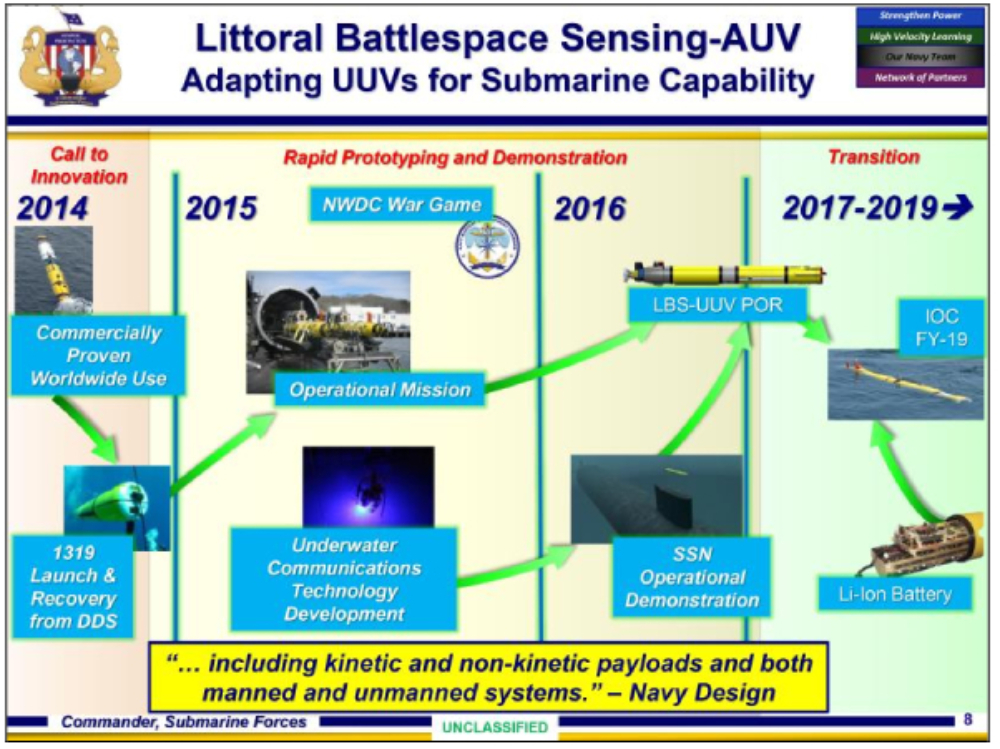
I do want to dive into this success story just a bit more, the Fleet Modular AUV, now as a program of record under the LBS- AUV, the Littoral Battlespace Sensing AUV. This is a great success story, a great example, of a tremendous team effort to pull something from a concept to actual demonstration in that two-year time period I mentioned.
Very, very exciting stuff: using commercial off the shelf Remus vehicles made by Hydroid, doing the 1319 launch and recovery experiments from a dry deck shelter, and then actually doing a real world mission in support of a Combatant Commander. We’re also working on some underwater communications technologies and plan to dovetail that into the program of record as well.
And we’ve still got some other great initiatives, including some lithium ion power density work we want to do. Hopefully that will come to fruition here in 2018, and bring that all together with something that can be launched from a dry deck shelter or from a torpedo tube if the mission is valuable enough, and either scuttle or recovered by a white ship.
So again, it’s a great example of innovation that we discussed on the previous slide, to include achieving it, in an impressive two-year timeframe. A lot of people in this room have been a big part of this success story, so my hat’s off to all of you.
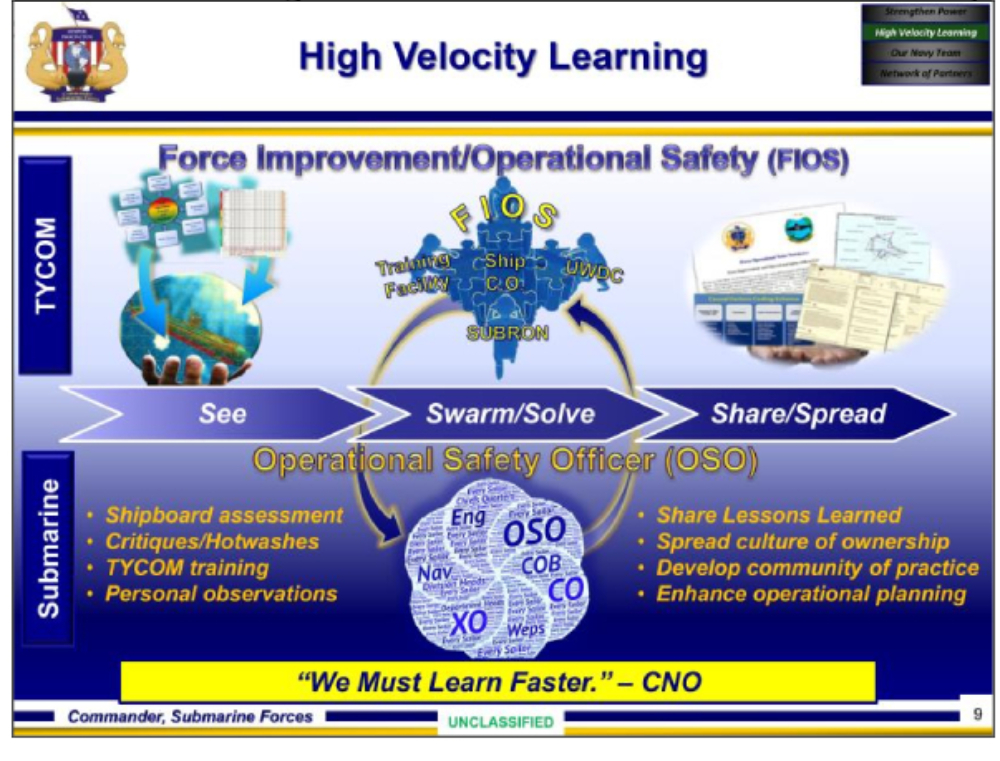
Here’s some more on high velocity learning and some stuff that’s going on in the force. The model that you see there has become pretty popular.
It comes from Dr. Steven Spear who wrote a book called The High Velocity Edge. If you haven’t read that, it’s something that we’re using a lot in our lexicon and our dialogue, and the way we’re thinking.
But I have to say even beyond that, I’ve opened my aperture on a couple of things that we can do better. Let’s start with the model see, swarm, solve, share, spread. Fundamentally, as nukes and submariners, we do a pretty good job of seeing things: monitor watches, post watch tours, audits/surveillances, you put your black hat or your red hat on or whatever hat you want to call it and you get out and see and learn and gather data and understand where you’re at.
We do a good job of swarming. A critique is a good example of the swarming process. And overall I’d say submariners are a pretty smart group of people who are good at solving problems. The right end of the spectrum is where we can do better, sharing and spreading. I think of sharing as something that a person or unit does, but spread is something that the institution or submarine force does.
Sure, we write those critique reports, those incident reports or those lessons learned, but we haven’t always done a good job of getting that back into the submarine force at the right place and at the right time so that lessons that are written in blood by somebody else don’t get written again. So we’re really working on that.
At the TYCOM level we’ve established this office called the Force Improvement Operational Safety Office, the FIOS office. You see that kind of at the center here. The CO is in the center of this little puzzle. The FIOS is a piece of that. The squadron is a piece of that: the training facilities; the Undersea Warfighting Development Center who works on the tactics, techniques, and procedures; the CONOPS. So at the TYCOM level, that’s one thing we’ve done.
At the submarine level we’ve established this thing called the Operational Safety Officer. Every single submarine now has a Junior Officer, who has a primary duty, to be the Operational Safety Officer. That’s a big paradigm shift from the way a lot of you in the room grew up.
If used correctly, this officer will help the CO, XO, Department Heads, all the division, get full utility out of the different tools we now have. From the new Lessons Learned Data Base, to Force Operational Notes, Technical, Organizational and Behavior Indicators or TOBI Reports, to improvement in Continuing Training and Qualification Software (CTQS), etc. I do not for a minute think that you have only one person in the wardroom that’s responsible for safety, absolutely not. Every single member of that wardroom is responsible for safety.
But this is a guy who helps the Captain do better at getting the lessons learned from other people in so that what we learn in one Carrier Strike Group ASW exercise are not relearned. We don’t have the time or the force structure to relearn lessons individually. We’ve got to try and get it right every first time that we possibly can, and that’s part of this learning faster piece.
So at the strategic level, this is a big part of what the submarine force leadership is trying to do. If done right, this will help us with the High Velocity Learning approach that the CNO has challenged us with.
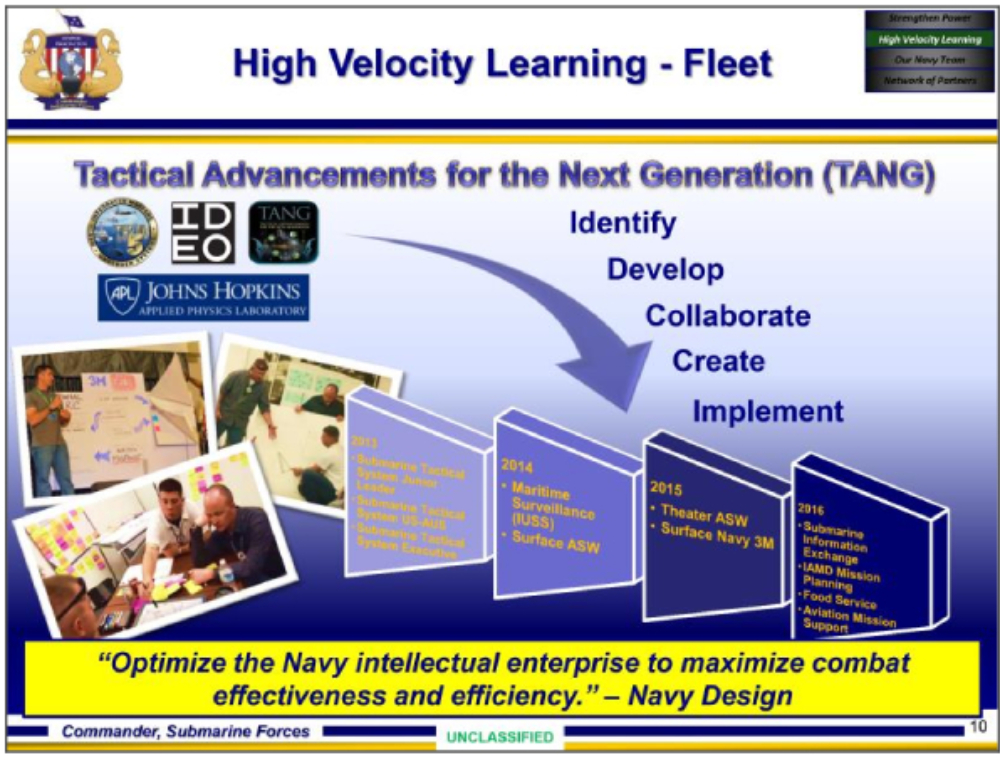
Let me give you a couple of examples of what the Submarine Force is doing here. I think a lot of folks in the room have probably heard of the TANG process. If you haven’t, it’s Tactical Advancements for the Next Generation. This is something that IWS-5, IDEO and Johns Hopkins work on together under the leadership primarily of IWS-5.
Let me give you an example. Let’s say you’re trying to work on sonar or a fire control system. Get the JOs, the chiefs, the petty officers in the room; take their uniforms off; civilian clothes, yellow stickies and magic markers, that kind of thing; thinking about how we can solve a problem better? What’s the right visual interface, the right button pushing? And really, in a high velocity manner, get to what’s needed so we can fold that back in and not have the same kind of challenges for everybody else going forward.
That’s an example. That was, in fact, the first one. We’ve done 11 of these now. They’ve become so popular that some of the ones, on the far right there, some of the ones in the bottom of those two columns are not even Submarine Force examples. They’ve been picked up by other communities as a way to improve their own high velocity learning. So this has truly been a success story.

I would submit to you that our Submarine Multi Mission Team Trainers, the SMMTTs, are a great example of high velocity learning. Here’s a trainer that’s integrated with the SWFTS model and what we call the two four stroke, you’re ability to every two years develop the software with the goal of updating it on hardware on platforms at four year intervals. We’ve modified that to probably more like four to six year intervals, but you can’t go much more than six years because you get into hardware obsolescence. At the same time you don’t want to spend a bunch of effort on episodic boutique gold-plated state of the art systems,
when state of the practice is totally adequate. In fact, it’s very darn good. But the key is to have that constant drum beat of working in the state of the practice where you’re refreshing your subs. So you’re spending your resources for the long haul in a predictable fashion that’s helpful for industry, not in more spread out episodic type model that are high end for a while but then don’t last.
And so because of that model we can update the SMMTT trainer at the same time we update different submarines in the same homeport, keeping our training in synch with our on-board systems. That’s extremely huge.
From a get faster standpoint, we have real world examples where we have taken potential adversary type platforms, whatever they may be: planes, ships, submarines, whatever; and one submarine will come back from a deployment with data on that. We will hand that over to the program manager, and that will get rolled in to the trainer such that the next crew going to deploy is training on it right away. I can’t think of a better example of high velocity learning, and this trainer allows us to do that.
Mission rehearsals and certification: I have Groton-based submarines that deploy to the western Pacific, and safely do so, because of their ability to train and rehearse in the exact environment they’re going to be in. The SSGN crews that Admiral Roegge and I deploy are airdropped onto a sea-framed platform that is deployed for 18 months.
That is unbelievable, to have a platform, a ship, out for that long that the crew is able to airdrop onto that platform in a place like Diego Garcia, and immediately go to sea and do their mission because they have done their rehearsal in that trainer. Our high SSGN Operational Availability could not be achieved without that.
If you have an untoward event or something that you want to really learn from, we can run every single Officer of the Deck, at a graduate level, through that scenario so that they know that they have lived and breathed whatever it was that you’re training on. It’s very, very powerful.
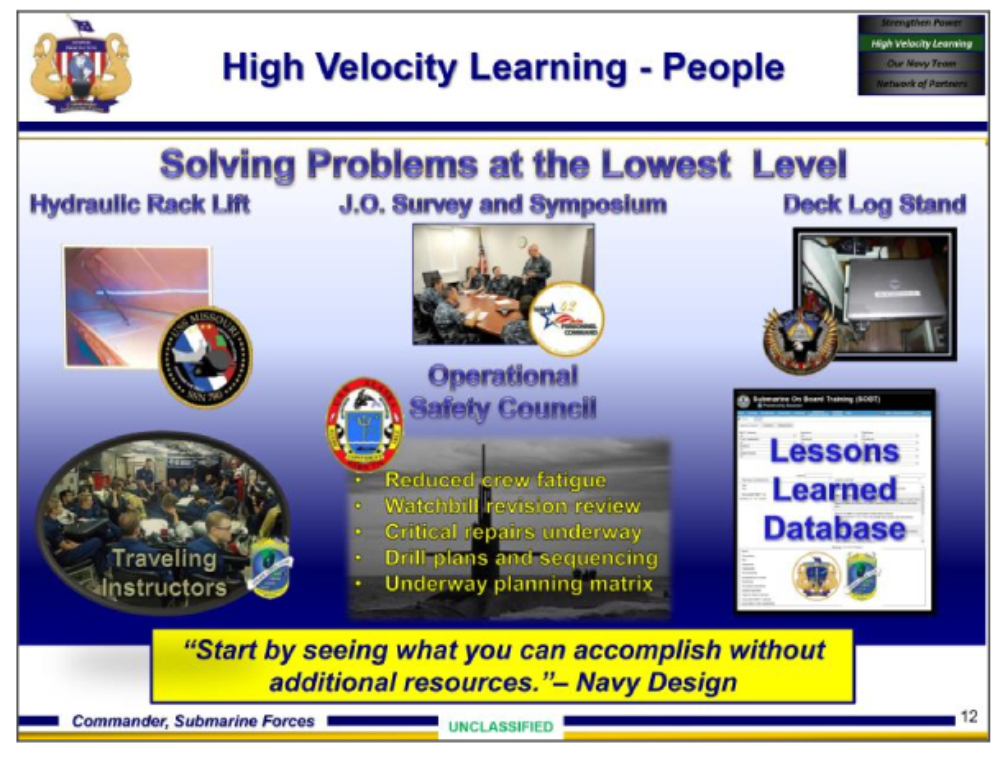
Some people examples. We’ve had a couple of examples here of late with Sailors. This one I love. Every submariner in the room has dropped their bunk pan on either their finger or onto something that was crushed when bunk fell. This young Sailor said, “Why can’t I have on my submarine bunk pan the same gas shocks that I have on my car hood?” It’s a really good question.
So there’s another example of some high velocity learning. We’re taking a hard look at making that a configuration change and something that submarines can reach out and do.
We’ve got a JO survey going on right now and a follow-on symposium, which I think is a good example of high velocity learning. We’re reaching right out to the JOs, the first JO survey that we’ve done in about a decade. It’s been a while, we really worked hard at it, and we got a tremendously high response rate.
Typically survey response rates are about one third of your potential sample size. We got 57 percent responders on this, with
really good hard-hitting feedback. So we’re going to work on that and we’re going to bring a couple of key JOs from the different concentration areas together on the 7th of December to talk even more about how to implement this feedback.
We’re using traveling instructors, a great idea from some of the folks at the junior level up in the training command. Why does every submarine in Norfolk or San Diego have to send certain Sailors to unique schools that may only be taught in Groton or Pearl Harbor? Why not bring the schoolhouse to the waterfront in key areas? It’s much more efficient and you’d probably get more people trained because the ship probably couldn’t afford to let some guys go.
And then a submarine database for lessons learned, I don’t know why it took us so long to get to the idea of taking that thing offline and let’s send it to the submarine, but how to do that? Well, why not use the SOBT products, Submarine On Board Training? So now we embed the lessons learned database in that. Every submarine gets those twice a year and they’ve got pretty much 98 percent of the submarine lessons learned data base at their disposal.
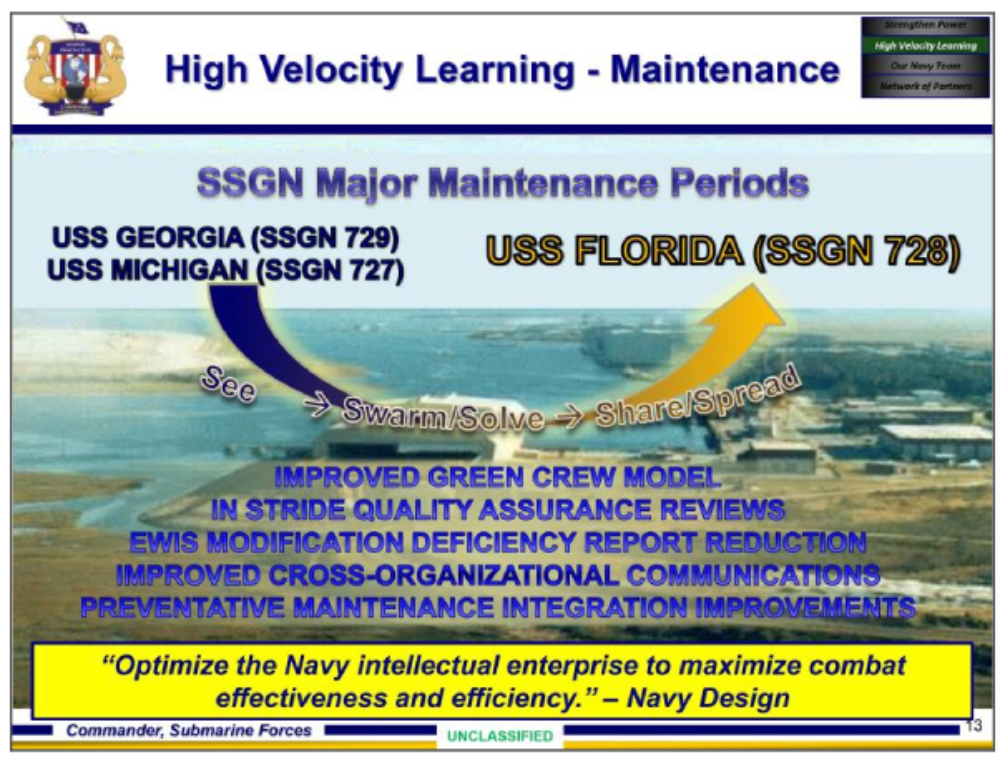
SSGN maintenance, we worked very hard on taking the les- sons learned from GEORGIA and MICHIGAN’s MMPs, Major Maintenance Period, and applying them to FLORIDA, which is going on now. There are some great examples there. In the interest of time I’m not going to dive into those.
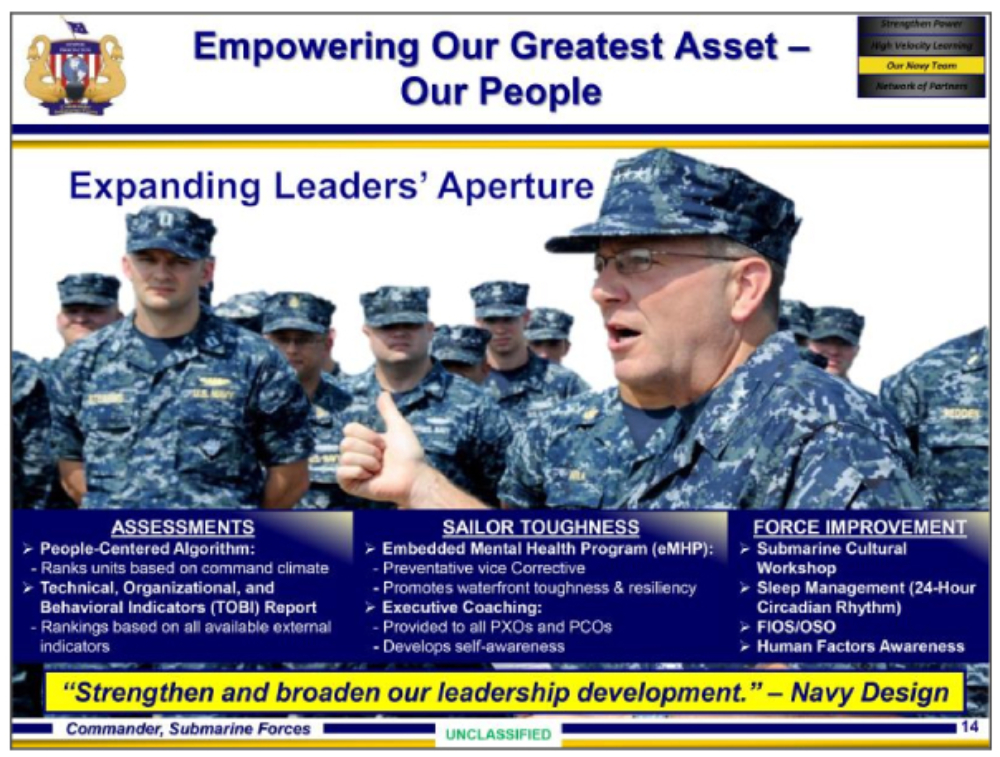
Let’s also talk about the people piece, which is obviously very important. Some of the initiatives include: assessments, Sailor toughness, which is one of the attributes from the Design, and then also Force improvement. We have a couple of new assessment tools. One is called the People centered metric. The other is this thing called TOBI, Technical, Organizational and Behavior Indicators. Actually, one of the inputs to TOBI is in fact the People centered metric thing.
I’m not going to get into the science behind that, but there is science behind it. We actually brought aboard a specialist, a Ph.D. level specialist on the SUBFOR staff to help us design these products. These tools help the dialogue between the Squadron and the sub, between the Commodore and the Skipper. They now have an additional common frame of reference from which to talk to, and the great thing is that no overhead is required of the submarine to create this.
A lot of us in this room know some of the precursors of this required the submarine to provide all kinds of data. Now the submarine is hands-off. It’s all data that we pull from “the Cloud” and put together in formula, and that allows the submarine to work on things they’re supposed to be working on.
Finally, the Embedded Mental Health Program, and Master Chief Capps is going to talk about this also, has been a huge success. Probably the biggest thing that we’ve gotten out of this initiative is changing and opening the aperture of leadership; changing how we think about some of the challenges, whether it’s mental health, removing the stigma of getting help, adding new terms to our vernacular and our dialogue, approaching things from a more preventative standpoint when we can, not to be afraid of that checkup from the neck up, as the SEALS say, which is exactly where our new Executive Coaching for the PXOs and PCOs came from.
My Force Medical Officer, Dr. Matt Hickey, is a Trident- wearing SEAL medical officer, so he came from that community and he’s helped us navigate this. It has gotten great reviews from the PXOs and the PCOs, and an understanding of how to change the dialogue and work on that. So to that end, I’ve already talked about the items on the right side of the slide. Go to the next slide and let me show you some of the results.
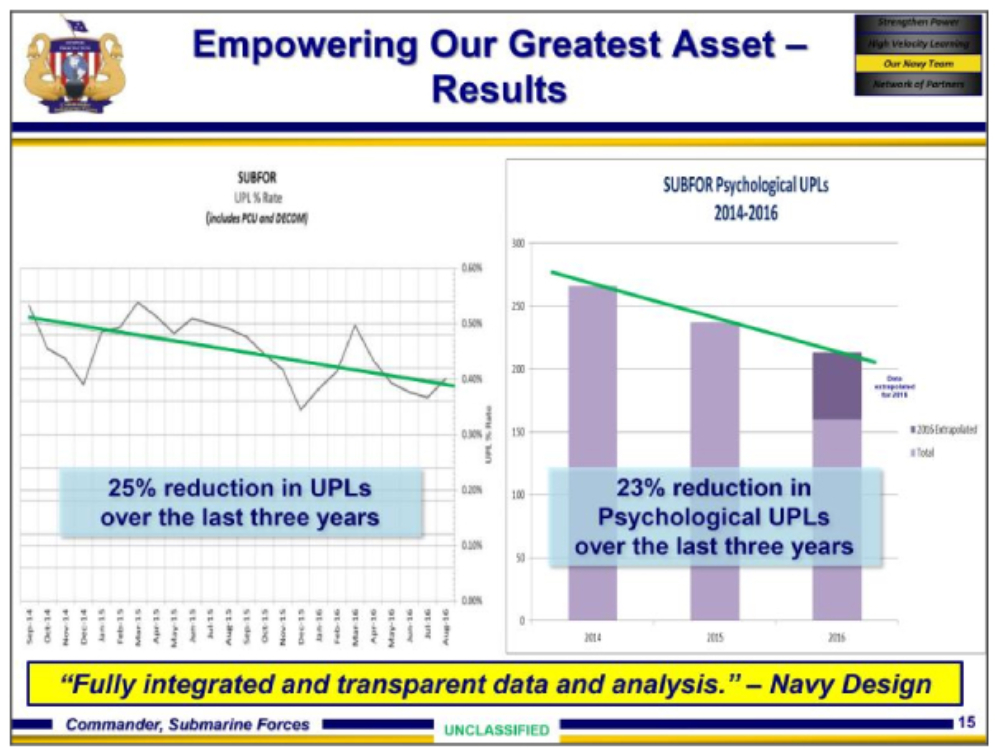
We’ve had a 25 percent reduction in unplanned losses in the last three years, with a 23 percent reduction in the psychological contributors to those unplanned losses. That’s fantastic. I will say that in the fleet concentration area where we did the pilot program, Norfolk, it was about 80 percent. In some of the other areas where we didn’t run the full pilot it was more like 20 percent hence, the average being where it is.
The point is, where we did the pilot, there really was an effect. There’s also an instrument called the OQ-45. It’s an instrument where you fill out and complete it and then you have an interaction with a trained psychologist or psychiatrist. We’ve actually seen, in the pilot program, an increase in those scores. So as a nuke, I’d call this is objective quality evidence of the ability to increase Sailor toughness and resiliency. I think that’s just fascinating, so pretty excited about that.
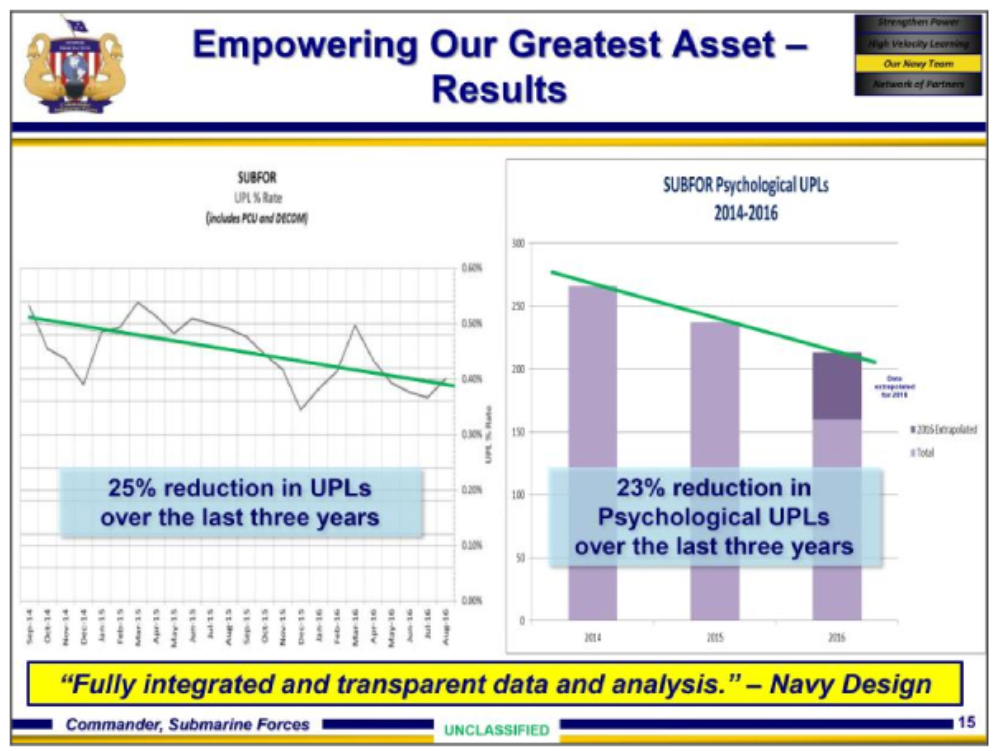
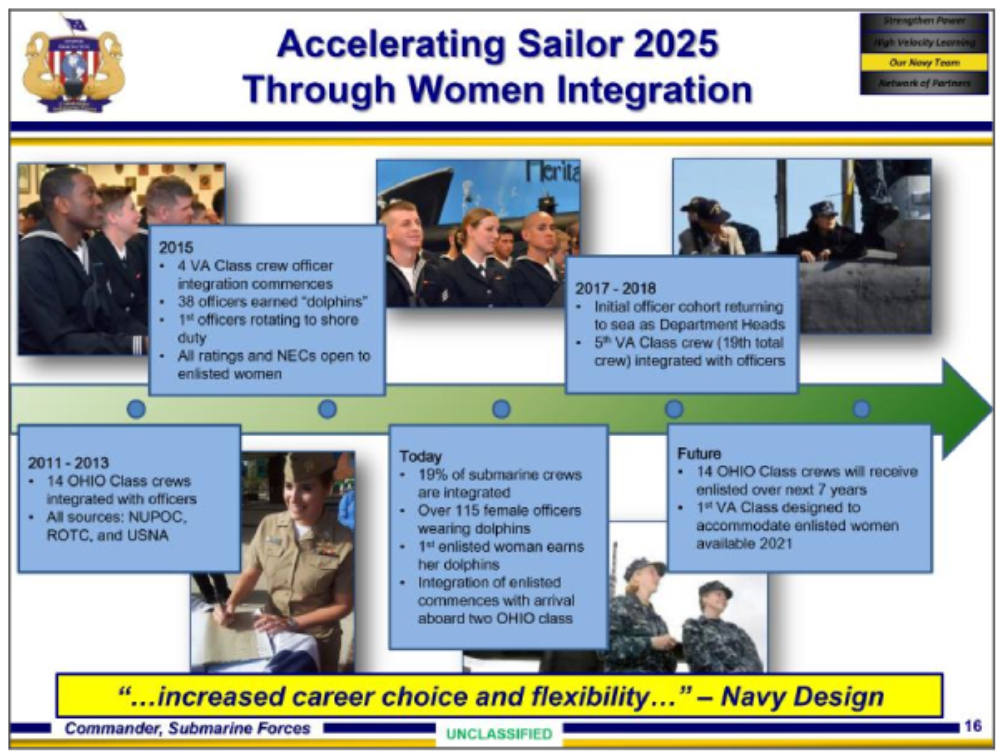
Women in submarines is going very well. We have about 19 percent of the force currently integrated. Over 115 female officers are wearing their dolphins.
As you know, a couple of years ago we started on the 14 Ohio-class crews being integrated with officers. In 2015 and 2016 we got four Virginia-class crews. Our 19th crew, WARNER, is going to happen in 2018 because we wanted to open one up in a fleet concentration area that’s more than just submarines.
A lot of the female submarine officers have a male spouse that is not a submariner, but might be a JAG or an aviator. So we wanted to get an integrated sub in Norfolk because that’s obviously a great place where there’s additional fleet concentration other than just the Submarine Force. And that was based on feedback from the women, so we heard them loud and clear.
We are just starting the enlisted integration. We have two crews that are in progress and right now we have the OHIO as the third. Our model is about two thirds conversions and about one third new accessions. All the nukes are new accessions because we don’t want to rob from the surface nuclear power program based on the small numbers there. So overall this effort is going well.
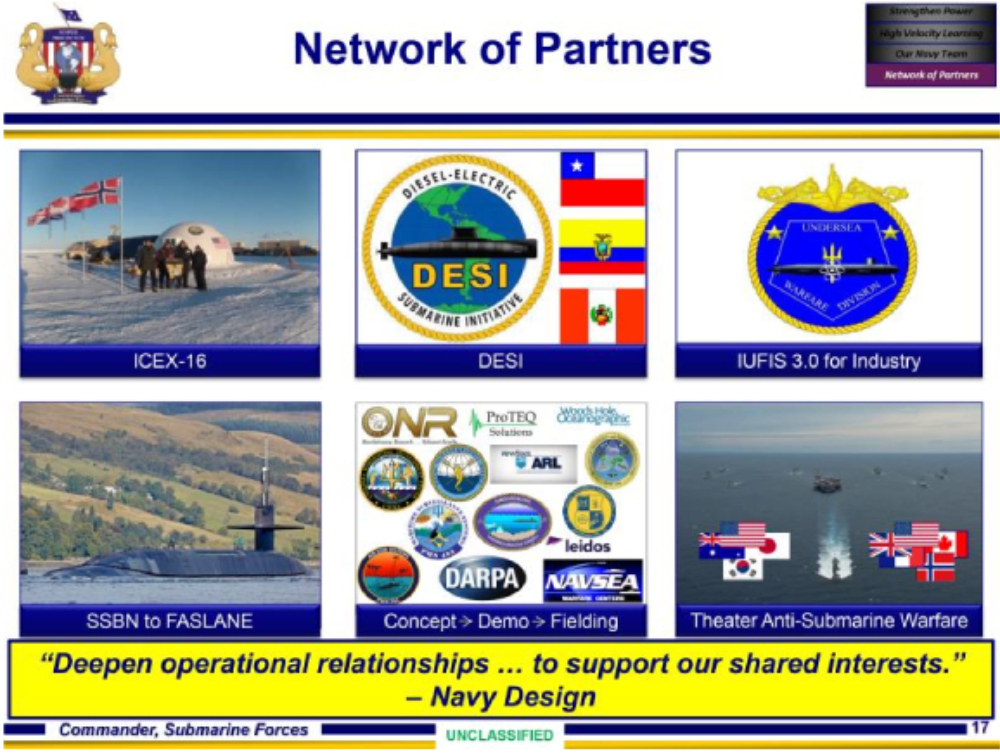
Finally, the Design talks about partners and I think we’ve got some great examples. I already mentioned ICEX-16 with the four different countries there. DESI, our Diesel Electric Submarine Initiative sets the standard for interactions in Fourth Fleet and in SOUTHCOM in a lot of ways. We work with Colombia, Peru, and Chile on this.
The Integrated Undersea Future Investment Strategy 3.0, this is Admiral Merz’s document. Admiral Richard built upon something that I had started when I was N97 where I had this IUFIS Executive Summary for Industry. I feel it’s important to communicate with industry because it’s a win win for both sides. Industry is more efficient, and more importantly, frankly, the American taxpayer’s dollar is used more efficiently. That’s a good thing.
But Admiral Richard built upon my smaller piece, which was our first stab at it, and now this IUFIS 3.0, Distro D, proper clearances and need to know of course, because it’s at the secret level. But it will allow a greater conversation with industry so that we can get to where we need to go faster. As the CNO said in the opening video, “the margins are razor thin, but they are decisive.”
Faslane, the USS WYOMING went there last year. If you saw on the news just a couple of weeks ago, TENNESSEE also went there a year ago. A great strategic message here. It’s showing the world what we already know, that we are everywhere on the planet with our SSBNs, and it is also a great message to assure our NATO partners and the UK, with whom we have a special relationship through our Polaris-Sales Agreement and the Common Missile Compartment in the Ohio Replacement.
As for our work in innovation, I can’t fit all the organizations and all the symbols on there for the team that is representative of this effort. Again, it’s a lot of folks in this room, so my hat’s off to all of you. It really is great work and something I’m very proud of.
And then, of course, our Theater ASW work. Admiral Roegge, I’m sure will talk about some of the flags there on the Pacific side, the ROKs, the Aussies, the Japanese; and on the Atlantic side, the Canadians, the Brits, the French and Norwegians; just all tremendous, tremendous partners. Theater ASW is a team sport, absolutely a team sport. The oceans are huge, and it really takes everyone and the way that we work together has just come so far in the last decade. It’s really something to be proud of.
Alright, that’s what I have for you this morning. Again, my goal was to demonstrate to you how the Submarine Force is 100 percent executing the Navy’s Design for Maintaining Maritime Superiority.

